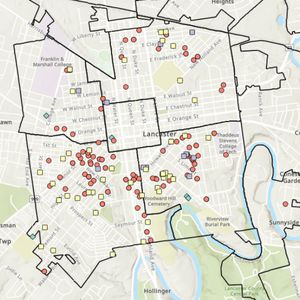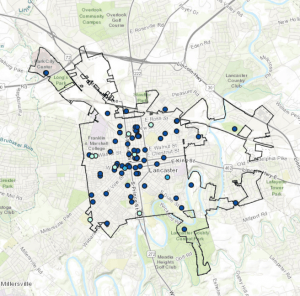DRAFT 2023 PRO Housing Application
Quality & Affordable Housing
This page is dedicated to the City of Lancaster’s efforts to preserve and create quality and affordable housing in our community. The City of Lancaster wants to increase the supply and diversity of housing in the city, with an emphasis on achieving affordable homes for both rent and purchase. “Achieving” affordable homes can take the form of producing affordable housing units in new buildings or finding ways to protect or redevelop affordable housing units in structures that already exist. Read the City’s Interim Housing Strategy here.
Affordable Housing
The City of Lancaster is committed to using all of the tools we have to create as many affordable housing units as possible. The availability of affordable housing is a key issue for our city residents and neighbors in Lancaster County. The City is making budgetary and programmatic commitments to increase affordable housing units. While the City has made this commitment, the City’s tools alone cannot solve this issue. Local governments like the City of Lancaster are funded through taxes, so the City depends on County, State and Federal funds to support this effort to avoid placing additional tax burden on City residents.
The Sorace Administration continues to advocate for increased federal and state funds toward creating affordable housing units in Lancaster City and County. Join us in this advocacy and go to cityoflancasterpa.com/take-action.

City of Lancaster Housing Investment Map (2018-2021)
“Affordable” here is defined as spending less than 30% of a household’s gross income on housing costs. Housing Cost Burdened is defined as spending 30% or more on housing costs.
Also, the Department of Housing and Urban Development (HUD) sets income limits that determine eligibility for housing assistance, usually for households earning less than 80% of the Area Median Income. For a family of four in Lancaster County, an annual income of $72,150 qualifies as “low income”.
Our current understanding of the city housing market is as follows (based on Comprehensive Housing Affordability Strategy data from 2012-2016).
Almost 8,500 households are housing cost burdened in the city (4,600 of those households are severely housing cost burdened). This represents about 38% of total households in need of housing that is more affordable. Of the 8,500 households that are housing cost burdened, the majority are Renter Households – approximately 6,500 households.
80% of the Area Median Income for a household of 4 is $72,150 in Lancaster County.
Lancaster City is home to at least 1,700 units of affordable housing units and more than 225 additional affordable units in production. As well, the Lancaster City Housing Authority manages more than 1,000 rent vouchers.
The best pathway to ensure that affordable housing is preserved for the long term is housing owned by nonprofits or cooperatives. Free market forces subject privately owned real estate to market trends, which continue to rise.
One current dynamic in Lancaster City is a housing demand that exceeds supply. As with every supply/demand dynamic, less supply means that prices increase. Currently Lancaster City is seeing a building boom with more than 1,500 total units of housing in development. There are approximately 23,743 dwelling units in Lancaster City. These new developments are more than have been developed at any one point in recent history. Increasing supply of housing at all levels will help stabilize increasing prices due to demand. As well, more than 15% of units in development are expected to be affordable, a rate at the top of national inclusionary zoning target goals of 6 – 15% of total units.
Other than demand, the single highest reason for this building boom are historic low interest rates and costs of capital for construction.
Nationwide, only 1 in 4 people who qualify for support receives any assistance, as it is not adequately funded at the State or Federal Level. Local governments like Lancaster City have few options to provide new solutions without raising taxes on our residents, who are already the lowest income and most highly taxed residents in Lancaster County. For this reason, support has to come from outside the city, including County, State and Federal support.
One of the biggest barriers to affordable housing is that total building costs exceed affordable sales and rental prices across the board. To build affordable housing – especially for low income families – it requires subsidy OR requires increased household income to afford more expensive housing.
Subsidies include federal (Section 8, HUD public housing, Low Income Housing Tax Credits) or state or local allocations of federal dollars or state/local versions of federal programs. Subsidies can also be from volunteer hours (i.e. Habitat for Humanity) or contributions to offset building costs utilized by nonprofit developers like SACA, Community Basics or HDC.
The City allocates funds each year to preserve safe, affordable housing through the Critical Repair Program, the Lead Hazard Reduction Program and the rental housing code compliance programs. In the next five-year plan with HUD, the City expects to allocate funds to increase affordable housing opportunities for residents. We have spent approximately $1.3 million per year in these areas over the past few years. As well in 2021, the City awarded $2.5 million in Federal HOME dollars to help create 82 affordable housing units.
Overall, governmental subsidies at the state and federal level have not kept up with demand, in fact many have decreased, leaving fewer options and the need for more creative approaches and increased advocacy.
Based on initial research, there are at least 1,700 units of permanent affordable housing units in Lancaster City and over 1,000 HUD supported vouchers distributed through the Lancaster City Housing Authority.
Units are owned and/or managed by nonprofit partners including: Lancaster City Housing Authority, HDC MidAtlantic, Spanish American Civic Association (SACA), and Community Basics.
One big answer: Advocacy.
Advocate for two key things:
Subsidies:
- Advocacy to the Federal Government for more Low-Income Housing Tax Credits. For more info, go to nlihc.org/explore-issues/housing-programs/tax-reform.
- Advocacy to the Federal Department of Housing & Urban Development for more housing vouchers and subsidies. For more info, go nlihc.org/explore-issues/housing-programs/vouchers
- Advocacy to the State for higher investments in the Low Income Housing Tax Credit program. For more info on housing advocacy in Pennsylvania, go to housingalliancepa.org.
Zoning:
- Zoning approvals for mixed income and higher density developments. Lancaster City strives to have flexible and welcoming zoning and a welcoming land development process for affordable housing developers. Often, elected officials in townships and municipalities outside of Lancaster City make these zoning decisions in environments with limited stakeholder advocacy for density and affordability. Advocacy in support of dense and affordable developments anywhere in Lancaster County, not just in Lancaster City, is one way people can help.
Other personal actions you can take include donating to a local fund to finance projects in the absence of adequate public subsidies. You can also donate to nonprofit housing developers to grow the supply of housing they own and manage for long-term affordability. In Lancaster these include: Community Action Partnership, Community Basics, Inc., HDC Mid-Atlantic, Lancaster City Housing Authority, Lancaster Equity, Tenfold, Lancaster Lebanon Habitat for Humanity, Spanish American Civic Association Development Corporation.
For one, when people spend too much of their income on housing, they spend less in the overall economy; on groceries, household goods, entertainment, etc. Affordable housing is an accelerator on our economy, contributes to integrated schools and better outcomes for students, closes the wealth gap, reduces healthcare costs and more.
Two – many households you may consider to be solidly middle-class are actually struggling to pay rent or afford a downpayment on a house. Many single working professionals struggle to find housing to afford at a professional salary. The costs of housing impact far more neighbors than one may realize.
And third, if you love Lancaster County – dense, affordable housing may save it. Lancaster County is an attractive place to live and is growing in population. If we keep building houses spread out on farm fields, all we’ll have is sprawling suburbs. Dense housing is also the most affordable housing, and preserves our irreplaceable farmland. The opportunity in Lancaster County is to build more densely in already built areas. In doing so, we’ll conserve our agricultural land and woodland while adding more housing.

